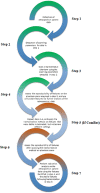The application of a workflow integrating the variable reproducibility and harmonizability of radiomic features on a phantom dataset
- PMID: 33961646
- PMCID: PMC8104396
- DOI: 10.1371/journal.pone.0251147
The application of a workflow integrating the variable reproducibility and harmonizability of radiomic features on a phantom dataset
Abstract
Radiomics-the high throughput extraction of quantitative features from medical images and their correlation with clinical and biological endpoints- is the subject of active and extensive research. Although the field shows promise, the generalizability of radiomic signatures is affected significantly by differences in scan acquisition and reconstruction settings. Previous studies reported on the sensitivity of radiomic features (RFs) to test-retest variability, inter-observer segmentation variability, and intra-scanner variability. A framework involving robust radiomics analysis and the application of a post-reconstruction feature harmonization method using ComBat was recently proposed to address these challenges. In this study, we investigated the reproducibility of RFs across different scanners and scanning parameters using this framework. We analysed thirteen scans of a ten-layer phantom that were acquired differently. Each layer was subdivided into sixteen regions of interest (ROIs), and the scans were compared in a pairwise manner, resulting in seventy-eight different scenarios. Ninety-one RFs were extracted from each ROI. As hypothesized, we demonstrate that the reproducibility of a given RF is not a constant but is dependent on the heterogeneity found in the data under analysis. The number (%) of reproducible RFs varied across the pairwise scenarios investigated, having a wide range between 8 (8.8%) and 78 (85.7%) RFs. Furthermore, in contrast to what has been previously reported, and as hypothesized in the robust radiomics analysis framework, our results demonstrate that ComBat cannot be applied to all RFs but rather on a percentage of those-the "ComBatable" RFs-which differed depending on the data being harmonized. The number (%) of reproducible RFs following ComBat harmonization varied across the pairwise scenarios investigated, ranging from 14 (15.4%) to 80 (87.9%) RFs, and was found to depend on the heterogeneity in the data. We conclude that the standardization of image acquisition protocols remains the cornerstone for improving the reproducibility of RFs, and the generalizability of the signatures developed. Our proposed approach helps identify the reproducible RFs across different datasets.
Conflict of interest statement
Dr. Philippe Lambin reports, within and outside the submitted work, grants/sponsored research agreements from Varian medical, Oncoradiomics, ptTheragnostic and Health Innovation Ventures. He received an advisor/presenter fee and/or reimbursement of travel costs/external grant writing fee and/or in kind manpower contribution from Oncoradiomics, BHV, Merck, Varian, Elekta and Convert pharmaceuticals. Dr. Lambin has (minority) shares in the company Oncoradiomics, MedC2, LivingMed Biotech and Convert pharmaceuticals and is co-inventor of two issued patents with royalties on radiomics (PCT/NL2014/050248, PCT/NL2014/050728) licensed to Oncoradiomics and one issue patent on mtDNA (PCT/EP2014/059089) licensed to ptTheragnostic/DNAmito, three nonpatentable invention (softwares) licensed to ptTheragnostic/DNAmito, Oncoradiomics and Health Innovation Ventures. Dr. Woodruff, and Dr. Leijenaar have (minority) shares in the company Oncoradiomics. Dr. Mottaghy received an advisor fee and reimbursement of travel costs from Oncoradiomics. He reports institutional grants from GE and Nanomab outside the submitted work. The rest of authors declare no competing interest. This does not alter our adherence to PLOS ONE policies on sharing data and materials.
Figures
Similar articles
-
Impact of harmonization on the reproducibility of MRI radiomic features when using different scanners, acquisition parameters, and image pre-processing techniques: a phantom study.Med Biol Eng Comput. 2024 Aug;62(8):2319-2332. doi: 10.1007/s11517-024-03071-6. Epub 2024 Mar 27. Med Biol Eng Comput. 2024. PMID: 38536580 Free PMC article.
-
In Vivo Repeatability and Multiscanner Reproducibility of MRI Radiomics Features in Patients With Monoclonal Plasma Cell Disorders: A Prospective Bi-institutional Study.Invest Radiol. 2023 Apr 1;58(4):253-264. doi: 10.1097/RLI.0000000000000927. Epub 2022 Sep 16. Invest Radiol. 2023. PMID: 36165988
-
Repeatability and Reproducibility of Computed Tomography Radiomics for Pulmonary Nodules: A Multicenter Phantom Study.Invest Radiol. 2022 Apr 1;57(4):242-253. doi: 10.1097/RLI.0000000000000834. Invest Radiol. 2022. PMID: 34743134 Free PMC article.
-
Making Radiomics More Reproducible across Scanner and Imaging Protocol Variations: A Review of Harmonization Methods.J Pers Med. 2021 Aug 27;11(9):842. doi: 10.3390/jpm11090842. J Pers Med. 2021. PMID: 34575619 Free PMC article. Review.
-
Repeatability and Reproducibility of Radiomic Features: A Systematic Review.Int J Radiat Oncol Biol Phys. 2018 Nov 15;102(4):1143-1158. doi: 10.1016/j.ijrobp.2018.05.053. Epub 2018 Jun 5. Int J Radiat Oncol Biol Phys. 2018. PMID: 30170872 Free PMC article.
Cited by
-
Test-Retest Data for the Assessment of Breast MRI Radiomic Feature Repeatability.J Magn Reson Imaging. 2022 Aug;56(2):592-604. doi: 10.1002/jmri.28027. Epub 2021 Dec 22. J Magn Reson Imaging. 2022. PMID: 34936160 Free PMC article.
-
Harmonizing CT scanner acquisition variability in an anthropomorphic phantom: A comparative study of image-level and feature-level harmonization using GAN, ComBat, and their combination.PLoS One. 2025 May 9;20(5):e0322365. doi: 10.1371/journal.pone.0322365. eCollection 2025. PLoS One. 2025. PMID: 40344028 Free PMC article.
-
MaasPenn Radiomics Reproducibility Score: A Novel Quantitative Measure for Evaluating the Reproducibility of CT-Based Handcrafted Radiomic Features.Cancers (Basel). 2022 Mar 22;14(7):1599. doi: 10.3390/cancers14071599. Cancers (Basel). 2022. PMID: 35406372 Free PMC article.
-
CT Reconstruction Kernels and the Effect of Pre- and Post-Processing on the Reproducibility of Handcrafted Radiomic Features.J Pers Med. 2022 Mar 31;12(4):553. doi: 10.3390/jpm12040553. J Pers Med. 2022. PMID: 35455668 Free PMC article.
-
External validation of an MR-based radiomic model predictive of locoregional control in oropharyngeal cancer.Eur Radiol. 2023 Apr;33(4):2850-2860. doi: 10.1007/s00330-022-09255-8. Epub 2022 Dec 3. Eur Radiol. 2023. PMID: 36460924
References
-
- Reiazi R, Abbas E, Faima P, Kwan JY, Rezaie A, Bratman SV, et al.. The Impact of the Variation of Imaging Factors on the Robustness of Computed Tomography Radiomic Features: A Review. medRxiv. 2020. - PubMed
Publication types
MeSH terms
LinkOut - more resources
Full Text Sources
Other Literature Sources
Research Materials


